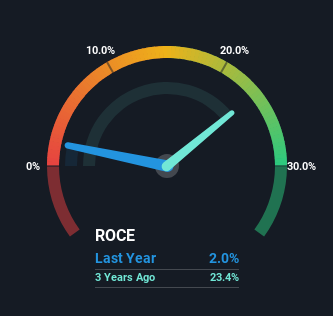- Hong Kong
- /
- Electronic Equipment and Components
- /
- SEHK:1723
HK Asia Holdings' (HKG:1723) Returns On Capital Not Reflecting Well On The Business
To find a multi-bagger stock, what are the underlying trends we should look for in a business? In a perfect world, we'd like to see a company investing more capital into its business and ideally the returns earned from that capital are also increasing. Ultimately, this demonstrates that it's a business that is reinvesting profits at increasing rates of return. However, after briefly looking over the numbers, we don't think HK Asia Holdings (HKG:1723) has the makings of a multi-bagger going forward, but let's have a look at why that may be.
Return On Capital Employed (ROCE): What Is It?
For those that aren't sure what ROCE is, it measures the amount of pre-tax profits a company can generate from the capital employed in its business. To calculate this metric for HK Asia Holdings, this is the formula:
Return on Capital Employed = Earnings Before Interest and Tax (EBIT) ÷ (Total Assets - Current Liabilities)
0.02 = HK$3.3m ÷ (HK$179m - HK$7.6m) (Based on the trailing twelve months to March 2023).
Therefore, HK Asia Holdings has an ROCE of 2.0%. In absolute terms, that's a low return and it also under-performs the Electronic industry average of 7.5%.
See our latest analysis for HK Asia Holdings

Historical performance is a great place to start when researching a stock so above you can see the gauge for HK Asia Holdings' ROCE against it's prior returns. If you'd like to look at how HK Asia Holdings has performed in the past in other metrics, you can view this free graph of past earnings, revenue and cash flow.
What The Trend Of ROCE Can Tell Us
On the surface, the trend of ROCE at HK Asia Holdings doesn't inspire confidence. Over the last five years, returns on capital have decreased to 2.0% from 54% five years ago. Although, given both revenue and the amount of assets employed in the business have increased, it could suggest the company is investing in growth, and the extra capital has led to a short-term reduction in ROCE. And if the increased capital generates additional returns, the business, and thus shareholders, will benefit in the long run.
On a side note, HK Asia Holdings has done well to pay down its current liabilities to 4.3% of total assets. So we could link some of this to the decrease in ROCE. What's more, this can reduce some aspects of risk to the business because now the company's suppliers or short-term creditors are funding less of its operations. Some would claim this reduces the business' efficiency at generating ROCE since it is now funding more of the operations with its own money.
The Bottom Line On HK Asia Holdings' ROCE
While returns have fallen for HK Asia Holdings in recent times, we're encouraged to see that sales are growing and that the business is reinvesting in its operations. Despite these promising trends, the stock has collapsed 94% over the last three years, so there could be other factors hurting the company's prospects. Therefore, we'd suggest researching the stock further to uncover more about the business.
If you want to know some of the risks facing HK Asia Holdings we've found 5 warning signs (2 are potentially serious!) that you should be aware of before investing here.
While HK Asia Holdings isn't earning the highest return, check out this free list of companies that are earning high returns on equity with solid balance sheets.
New: Manage All Your Stock Portfolios in One Place
We've created the ultimate portfolio companion for stock investors, and it's free.
• Connect an unlimited number of Portfolios and see your total in one currency
• Be alerted to new Warning Signs or Risks via email or mobile
• Track the Fair Value of your stocks
Have feedback on this article? Concerned about the content? Get in touch with us directly. Alternatively, email editorial-team (at) simplywallst.com.
This article by Simply Wall St is general in nature. We provide commentary based on historical data and analyst forecasts only using an unbiased methodology and our articles are not intended to be financial advice. It does not constitute a recommendation to buy or sell any stock, and does not take account of your objectives, or your financial situation. We aim to bring you long-term focused analysis driven by fundamental data. Note that our analysis may not factor in the latest price-sensitive company announcements or qualitative material. Simply Wall St has no position in any stocks mentioned.
About SEHK:1723
Moon
An investment holding company, engages in the wholesale and retail sale of the pre-paid products in Hong Kong.
Flawless balance sheet with low risk.
Market Insights
Community Narratives


Recently Updated Narratives


MINISO's fair value is projected at 26.69 with an anticipated PE ratio shift of 20x


Fiverr International will transform the freelance industry with AI-powered growth

Constellation Energy Dividends and Growth
Popular Narratives


MicroVision will explode future revenue by 380.37% with a vision towards success


NVDA: Expanding AI Demand Will Drive Major Data Center Investments Through 2026



